EU regulators have called for a “sustainability indicator” for all funds with environmental and social objectives under the Sustainable Finance Disclosure Regulation (SFDR).
In its feedback to the European Commission, the European Supervisory Authority (ESA) said a scale for funds “could simplify complex sustainability information” and make it “more easily digestible for consumers”.
It said consumer feedback has shown investors “struggle to understand” funds’ sustainability objectives under current SFDR disclosures.
Under the ESA’s proposals, there would be two product categories; ‘Sustainable’, which could be split into environmental or social, and ‘Transition’, for funds that invest in assets that are not yet sustainable but will improve over time.
It said the indicator could have a narrow focus initially, measuring climate change mitigation based on financed emissions, or a broader category granting a grade to the level of sustainable and transitional investments.
This could be set using a decarbonisation target, the ESA said.
It added a grading sale could take the form of letters or colours, with red identifying the most harmful products and green the most ambitious.
For it to be effective, the ESA said the scale would need to rely on clear criteria, related to the EU taxonomy, decarbonisation targets, fossil fuel exposures and greenhouse gas intensity.
Despite this, it said developing “precise and objective criteria” would be a challenge and added it would likely lead to an increase in compliance costs for asset managers.
It also said a single indicator would not show retail investors the specific objective of the fund.
Commenting on the proposals, Bhavik Parekh, research associate and MainStreet Partners, said the ESA's approach could in fact increase confusion.
“The new joint opinion by the ESAs, if implemented into regulation, would represent a total shift in the direction of sustainable fund regulation," he said.
"Implementing an indicator approach would potentially be more confusing especially if combined with categories.
"As acknowledged by the ESAs, the definition of a 'sustainable investment' is not easily compared between asset managers and likewise, we believe the same problem would be present with indicators, hence our preference for the category option."
The European Commission launched a review of its flagship sustainable regulation last September, with mast asset managers supporting a new categorisation system to replace the current Article 8 and 9 categories.
It comes as the European Securities and Markets Authority (ESMA) – part of the ESA – published its fund naming rules in May.
Under the rules, ETFs using the term ESG or sustainable in their name must have at least 80% of investments tied to environmental or social characteristics, while funds must also adhere to the Paris-Aligned Benchmark (PAB) exclusion metrics.




